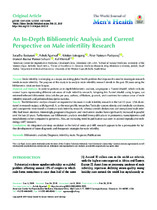| dc.description.abstract | PURPOSE: Male infertility is emerging as a major, escalating global health problem that imposes the need to investigate research
trends in male infertility. The purpose of this study is to analyze male infertility research trends in the past 20 years using the
bibliometric database from Scopus.
MATERIALS AND METHODS: In order to perform an in-depth bibliometric analysis, we propose a ‘Funnel Model’, which includes
several layers representing different sub-areas of male infertility research. Adopting this Funnel Model, using Scopus, we
retrieved relevant bibliometric data (articles per year, authors, affiliations, journals, and countries) for various areas of male
infertility research and performed descriptive statistics.
RESULTS: The bibliometric analysis showed an exponential increase in male infertility research in the last 20 years. USA dominated
in research output, with Agarwal, A. as the most prolific researcher. Testicular cancer, obesity and metabolic syndrome,
and azoospermia were found to dominate male infertility research, whereas erectile dysfunction and unexplained male infertility
had lesser attention. Interestingly, prognostic/diagnostic and mechanistic studies have significantly increased in parallel
over the last 20 years. Furthermore, our bibliometric analysis revealed fewer publications in proteomics, transcriptomics and
metabolomics when compared to genomics. Also, an increasing trend in publication was seen in assisted reproductive technology
(ART) research.
CONCLUSIONS: An integrated and steep escalation in the field of omics and ART research appears to be a prerequisite for further
development of future diagnostic and therapeutic strategies for male infertility. | en_US |

